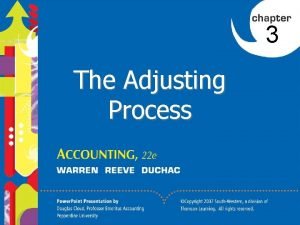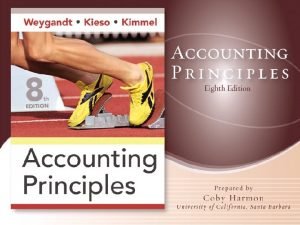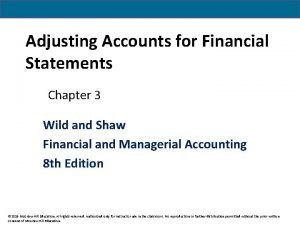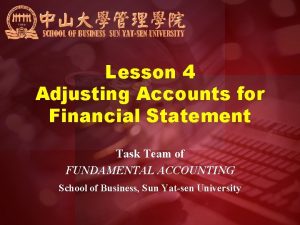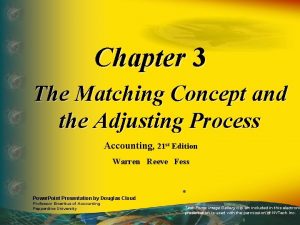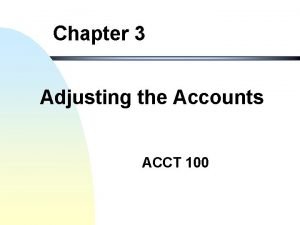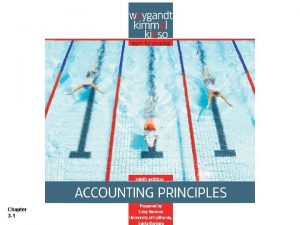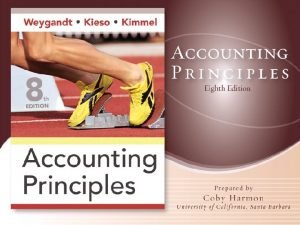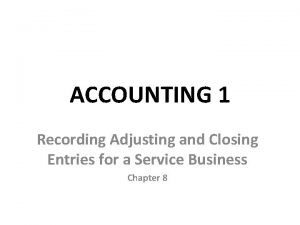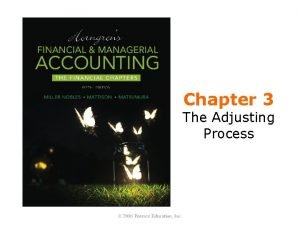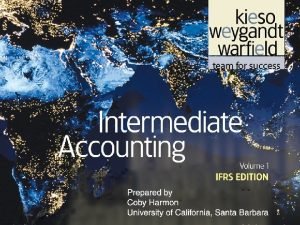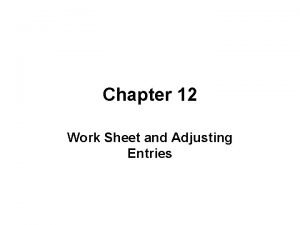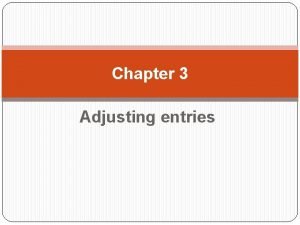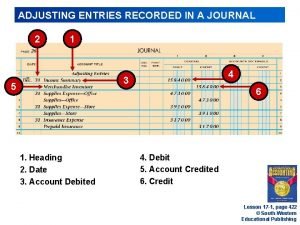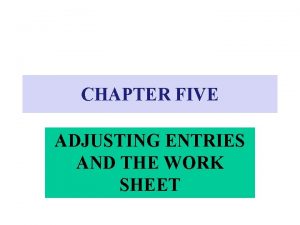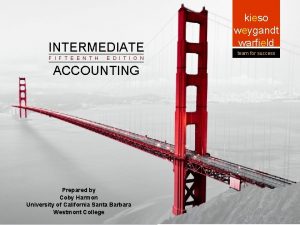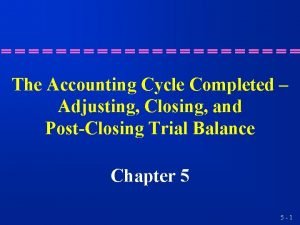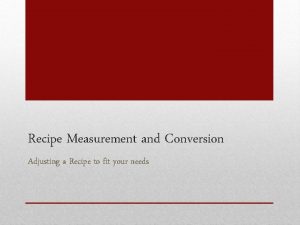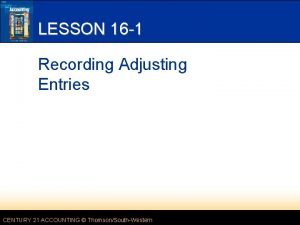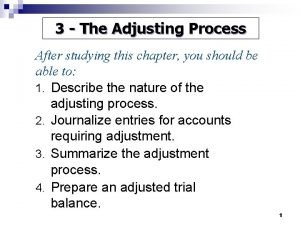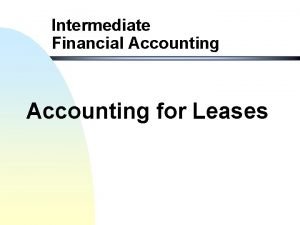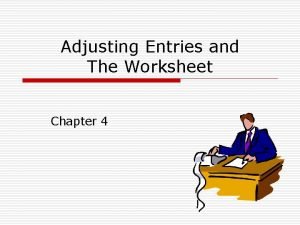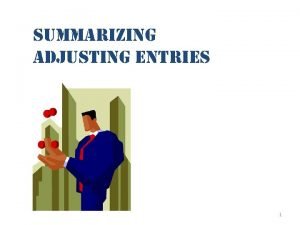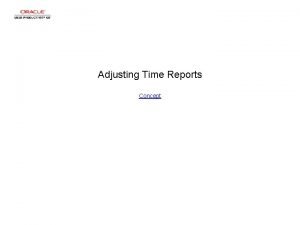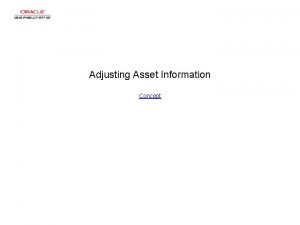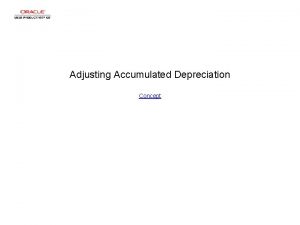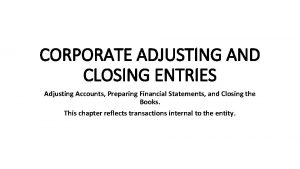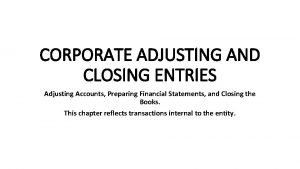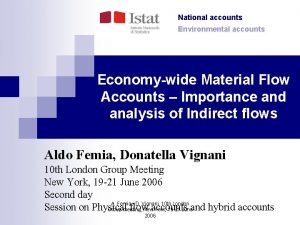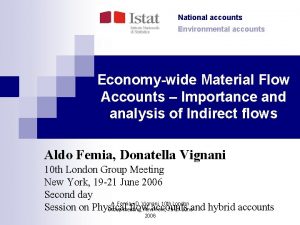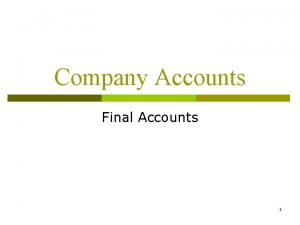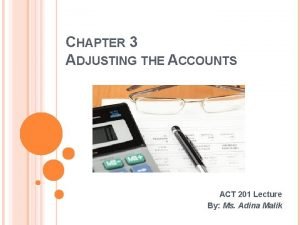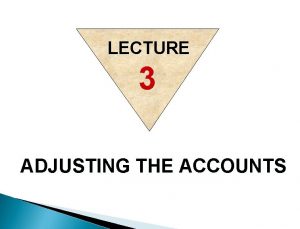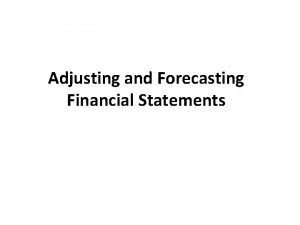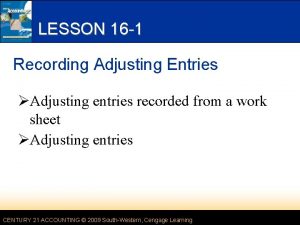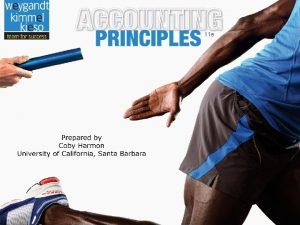Lecture 6 Adjusting the Accounts Lecture 6 Adjusting







































































- Slides: 71

Lecture # 6: Adjusting the Accounts

Lecture # 6: Adjusting the Accounts

Lecture # 6: Adjusting the Accounts

LECTURE # 5 SUMMARY Lecture # 6: Adjusting the Accounts

SUMMARY Lect# 5 § Discussed the role of accounting records in an organisation. § Described a ledger account and a ledger. § Described the rules of Debit and Credit for balance sheet accounts. § Explained the Double-Entry rule of accounting. § Explained the nature of net income/loss, revenue and expenses. § Explained why revenues are credited and expenses are recorded with debits. Lecture # 6: Adjusting the Accounts

SUMMARY Lect# 5 § Applied the realization and matching principles in recording revenues and expenses. § Described the steps in accounting cycle. § Prepared a trial balance explained its uses and limitations. § Explained the nature of adjusting entries. § Explained the purposes of closing entries, prepared these entries. Lecture # 6: Adjusting the Accounts

LECTURE 6 Principles of Accounting Lecture # 6: Adjusting the Accounts © human/i. Stockphoto

LECTURE 6 ADJUSTING THE ACCOUNTS Lecture # 6: Adjusting the Accounts

USING THE INFORMATION IN THE FINANCIAL STATEMENTS • Annual Reports – Non-financial information – Financial information

Continuity § The majority of companies present annual financial statements on the assumption that the business will continue to operate indefinitely—that is, that the company is a going concern. Lecture # 6: Adjusting the Accounts

Continuity § The continuity assumption states that unless there is evidence to the contrary, the accountant assumes that the business is a going concern and will continue to operate indefinitely. – The continuity assumption allows certain expense and revenue transactions to be allocated over several accounting periods. Lecture # 6: Adjusting the Accounts

Periodicity § The periodicity assumption states that although the lifetime of a business is uncertain, it is nonetheless useful to estimate the business’s net income in terms of accounting periods. Lecture # 6: Adjusting the Accounts

Periodicity § A 12 -month accounting period is called a fiscal year. – The fiscal year may be the same as the calendar year or some other 12 month period. § Accounting periods of less than a year are called interim periods. Lecture # 6: Adjusting the Accounts

TIME PERIOD ASSUMPTION l The time period (or periodicity) assumption assumes that the economic life of a business can be divided into artificial time periods — generally a month, a quarter, or a year. l Periods of less than one year are called interim periods. l The accounting time period of one year in length is usually known as a fiscal year. Lecture # 6: Adjusting the Accounts

THE MATCHING PRINCIPLE l The practice of expense recognition is referred to as the matching principle. l The matching principle dictates that efforts (expenses) be matched with accomplishments (revenues). Revenues earned this month are offset against. . Lecture # 6: Adjusting the Accounts expenses incurred in earning the revenue

ACCRUAL BASIS OF ACCOUNTING l Adheres to the GAAP l Revenue recognition principle l Matching principle l Revenue recorded when earned, not only when cash received. l Expense recorded when services or goods are used or consumed in the generation of revenue, not only when cash paid. Lecture # 6: Adjusting the Accounts

Concepts Underlying Accrual Accounting – With this method, taxable income is calculated as the difference between cash receipts from revenues and cash payments for expenses. § In accrual accounting, revenues and expenses are recorded when they are earned or incurred rather than when they are received or paid. Lecture # 6: Adjusting the Accounts

REVENUE RECOGNITION PRINCIPLE l The revenue recognition principle states that revenue should be recognized in the accounting period in which it is earned. l In a service business, revenue is usually considered to be earned at the time the service is performed. l In a merchandising business, revenue is usually earned at the time the goods are delivered. Lecture # 6: Adjusting the Accounts

Accrual Accounting (Matching Rule) § Under accrual accounting (often referred to as the matching rule) net income is measured by assigning: – Revenues to the accounting period in which the goods are sold or the services performed. Lecture # 6: Adjusting the Accounts

Accrual Accounting (Matching Rule) – Expenses to the accounting period in which they are used to produce revenue. § When there is no direct means of connecting expenses and revenues, costs are allocated among the accounting periods that benefit from the costs. Lecture # 6: Adjusting the Accounts

Concepts Underlying Accrual Accounting § The cash basis of accounting is the practice of accounting for revenues in the period in which cash is received and for expenses in the period in which cash is paid. Lecture # 6: Adjusting the Accounts

Concepts Underlying Accrual Accounting – With this method, taxable income is calculated as the difference between cash receipts from revenues and cash payments for expenses. § In accrual accounting, revenues and expenses are recorded when they are earned or incurred rather than when they are received or paid. Lecture # 6: Adjusting the Accounts

Recognizing Revenues § The process of determining when revenue should be recorded is called revenue recognition. § The Securities and Exchange Commission requires that all the following conditions be met before revenue is recognized: Lecture # 6: Adjusting the Accounts

Recognizing Revenues – Persuasive evidence of an arrangement exists. – A product or service has been delivered. – The seller’s price to the buyer is fixed or determinable. – Collectability is reasonably ensured. Lecture # 6: Adjusting the Accounts

Recognizing Expenses § Expenses are recorded when all of the following conditions are met: – There is an agreement to purchase goods or services. – The goods have been delivered or the services rendered. Lecture # 6: Adjusting the Accounts

Recognizing Expenses – A price has been determined or can be determined. – The goods or services have been used to produce revenue. § The recognition of the expense does not depend on the payment of cash. Lecture # 6: Adjusting the Accounts

CASH BASIS OF ACCOUNTING l Revenue recorded only when cash received. T NO AP GA l Expense recorded only when cash paid.

ADJUSTING ENTRIES l Adjusting entries make the revenue recognition and matching principles HAPPEN! Lecture # 6: Adjusting the Accounts

ILLUSTRATION TRIAL BALANCE The Trial Balance is analysed to determine the need for adjusting entries. Lecture # 6: Adjusting the Accounts

ADJUSTING ENTRIES l Adjusting entries are required each time financial statements are prepared. l Adjusting entries can be classified as 1. prepayments (prepaid expenses or unearned revenues), 2. accruals (accrued revenues or accrued expenses), or 3. estimates (amortization). Lecture # 6: Adjusting the Accounts

TYPES OF ADJUSTING ENTRIES Prepayments 1. Prepaid Expenses — Expenses paid in cash and recorded as assets before they are used or consumed. 2. Unearned Revenues — Revenues received in cash and recorded as liabilities before they are earned. Lecture # 6: Adjusting the Accounts

TYPES OF ADJUSTING ENTRIES Accruals 1. Accrued Revenues — Revenues earned but not yet received in cash or recorded. 2. Accrued Expenses — Expenses incurred but not yet paid in cash or recorded. Lecture # 6: Adjusting the Accounts

TYPES OF ADJUSTING ENTRIES Estimates 1. Depreciation / Amortization — Allocation of the cost of capital assets to expense over their useful lives. Lecture # 6: Adjusting the Accounts

PREPAYMENTS l Prepayments are either prepaid expenses or unearned revenues. l Adjusting entries for prepayments are required to record the portion of the prepayment that represents 1. the expense incurred or, 2. the revenue earned in the current accounting period. Lecture # 6: Adjusting the Accounts

PREPAID EXPENSES l Prepaid expenses are expenses paid in cash and recorded as assets before they are used or consumed. l Prepaid expenses expire with the passage of time or through use and consumption. l An asset-expense account relationship exists with prepaid expenses. Lecture # 6: Adjusting the Accounts

PREPAID EXPENSES l Prior to adjustment, assets are overstated and expenses are understated. l The adjusting entry results in a debit to an expense account and a credit to an asset account. l Examples of prepaid expenses include supplies, rent, insurance, and property tax. Lecture # 6: Adjusting the Accounts

UNEARNED REVENUES l Unearned revenues are revenues received and recorded as liabilities before they are earned. l Unearned revenues are subsequently earned by performing a service or providing a good to a customer. l A liability-revenue account relationship exists with unearned revenues. Lecture # 6: Adjusting the Accounts

UNEARNED REVENUES l Prior to adjustment, liabilities are overstated and revenues are understated. l The adjusting entry results in a debit to a liability account and a credit to a revenue account. l Examples of unearned revenues include rent, magazine subscriptions, airplane tickets, and tuition. Lecture # 6: Adjusting the Accounts

ILLUSTRATION 6 -2 ADJUSTING ENTRIES FOR PREPAYMENTS Adjusting Entries Prepaid Expenses Expense Asset Debit Adjusting Entry (+) Unadjuste Credit d Balance Adjusting Entry (-) Unearned Revenues Revenue Liability Debit Adjusting Entry (-) Unadjusted Balance Lecture # 6: Adjusting the Accounts Credit Adjusting Entry (+)

ACCRUALS l A different type of adjusting entry is accruals. l Adjusting entries for accruals are required to record revenues earned and expenses incurred in the current period. l The adjusting entry for accruals will increase both a balance sheet and an income statement account. Lecture # 6: Adjusting the Accounts

ACCRUED REVENUES l Accrued revenues may accumulate with the passing of time or through services performed but not billed or collected. l An asset-revenue account relationship exists with accrued revenues. l Prior to adjustment, assets and revenues are understated. Lecture # 6: Adjusting the Accounts

ACCRUED REVENUES l The adjusting entry requires a debit to an asset account and a credit to a revenue account. l Examples of accrued revenues include accounts receivable, rent receivable, and interest receivable. Lecture # 6: Adjusting the Accounts

ACCRUED EXPENSES l Accrued expenses are expenses incurred but not yet paid. l A liability-expense account relationship exists. l Prior to adjustment, liabilities and expenses are understated. Lecture # 6: Adjusting the Accounts

ACCRUED EXPENSES l The adjusting entry results in a debit to an expense account and a credit to a liability account. l Examples of accrued expenses include accounts payable, rent payable, salaries payable, and interest payable. Lecture # 6: Adjusting the Accounts

ILLUSTRATION 6 -3 FORMULA TO CALCULATE INTEREST Face Value of Note x Annual Interest Rate x $5, 000 x 6% x Time (in Terms of One Year) Lecture # 6: Adjusting the Accounts 1/12 = = Interest $25

ADJUSTING ENTRIES FOR ACCRUALS Adjusting Entries Accrued Revenues Asset Revenue Debit Adjusting Entry (+) Credit Adjusting Entry (+) Accrued Expenses Liability Expense Debit Adjusting Entry (+) Lecture # 6: Adjusting the Accounts Credit Adjusting Entry (+)

DEPRECIATION l Depreciation / Amortization is the process of allocating the cost of certain capital assets to expense over their useful life in a rational and systematic manner. l Amortization attempts to match the cost of a long-term, capital asset to the revenue it generates each period. Lecture # 6: Adjusting the Accounts

DEPRECIATION l. Depreciation is an estimate rather than a factual measurement of the cost that has expired. We’re not attempting to reflect the actual change in value of an asset! Lecture # 6: Adjusting the Accounts

DEPRECIATION l In recording amortization, Depreciation Expense is debited and a contra asset account, Accumulated Depreciation, is credited. Amortization Expense Accumulated Amortization Lecture # 6: Adjusting the Accounts

DEPRECIATION In recording amortization, Depreciation Expense is debited and a contra asset account, Accumulated Depreciation, is credited. Lecture # 6: Adjusting the Accounts

DEPRECIATION l The difference between the cost of the asset and its related accumulated amortization is referred to as the net book value of the asset. Depreciation Expense Accumulated Depreciation xxx Lecture # 6: Adjusting the Accounts

DEPRECIATION Balance Sheet Presentation Office equipment $5, 000 Less: Accumulated Estimate amortization 83 Net book value $4, 917 Lecture # 6: Adjusting the Accounts

ILLUSTRATION 6 -4 SUMMARY OF ADJUSTING ENTRIES Type of Adjustment Account Relationship Accounts before Adjustment Adjusting Entry 1. Prepaid Assets and Assets overstated Dr. Expenses expenses Expenses understated Cr. Assets 2. Unearned Liabilities and Liabilities overstated Dr. Liabilities revenues Revenues understated Cr. Revenues 3. Accrued Assets and Assets understated Dr. Assets revenues Revenues understated Cr. Revenues 4. Accrued Expenses and Expenses understated Dr. Expenses expenses liabilities Liabilities understated Cr. Liabilities 5. Depreciation Expense Lecture and# 6: Adjusting Expenses understated Dr. the Accounts

ADJUSTED TRIAL BALANCE l An Adjusted Trial Balance is prepared after all adjusting entries have been journalized and posted. l It shows the balances of all accounts at the end of the accounting period and the effects of all financial events that have occurred during the period. Lecture # 6: Adjusting the Accounts

ADJUSTED TRIAL BALANCE l It proves the equality of the total debit and credit balances in the ledger after all adjustments have been made. l Financial statements can be prepared directly from the adjusted trial balance. Lecture # 6: Adjusting the Accounts

ILLUSTRATION 6 -4 TRIAL BALANCE AND ADJUSTED TRIAL BALANCE COMPARE Lecture # 6: Adjusting the Accounts

PREPARING FINANCIAL STATEMENTS Financial statements can be prepared directly from an adjusted trial balance. 1. The income statement is prepared from the revenue and expense accounts. Lecture # 6: Adjusting the Accounts

PREPARING FINANCIAL STATEMENTS 2. The statement of owner’s equity is derived from the owner’s capital and drawings accounts and the net income (or net loss) shown in the income statement. 3. The balance sheet is then prepared from the asset and liability accounts and the ending owner’s capital balance as reported in the statement of owner’s equity. Lecture # 6: Adjusting the Accounts

ILLUSTRATION 6 -6 PREPARATION OF THE INCOME STATEMENT AND THE STATEMENT OF OWNER’S EQUITY FROM THE ADJUSTED TRIAL BALANCE Lecture # 6: Adjusting the Accounts

ILLUSTRATION 6 -7 PREPARATION OF THE BALANCE SHEET FROM THE ADJUSTED TRIAL BALANCE From Statement of Owner’s Equity Lecture # 6: Adjusting the Accounts

STEPS IN THE ACCOUNTING CYCLE 1. Analyze transactions 2. Journalize the transactions 9. Coming next chapter 3. Post to ledger accounts 8. Coming next chapter 7. Prepare financial statements 4. Prepare a trial balance 6. Prepare adjusted trial balance Lecture # 6: Adjusting the Accounts 5. Journalize and post adjusting entries

Net Income: Ethical Measurement and Cash Flows § Adjusting entries affect net income and the assets and liabilities on the balance sheet that are used to assess the need for cash. § Because judgment underlies the adjusting entries, there is potential for abuse. Lecture # 6: Adjusting the Accounts

Net Income: Ethical Measurement and Cash Flows § The manipulation of revenue and expenses to achieve a specific outcome is called earnings management. – When estimates move outside a reasonable range, financial statements become misleading. Lecture # 6: Adjusting the Accounts

ETHICS Ethics Standard of conduct l Ethical Dilemma Solution 1. Identify the situation and ethical issues involved 2. Analyse elements 3. Find out the alternatives and do the cost benefit analysis

LECTURE # 6 SUMMARY Lecture # 6: Adjusting the Accounts

SUMMARY OF THE LECTURE # 6 § That the company is a going concern. § It is nonetheless useful to estimate the business’s net income in terms of accounting periods. § That the economic life of a business can be divided into artificial time periods Lecture # 6: Adjusting the Accounts

SUMMARY OF THE LECTURE # 6 § That revenue should be recognized in the accounting period in which it is earned. § In accrual accounting, revenues and expenses are recorded when they are earned or incurred § Adjusting recognition happen. entries and make the matching Lecture # 6: Adjusting the Accounts revenue principles

SUMMARY OF THE LECTURE # 6 § Prepayments are either prepaid expenses or unearned revenues § Unearned revenues are revenues received and recorded as liabilities before they are earned. Lecture # 6: Adjusting the Accounts

Lecture # 6: Adjusting the Accounts

Lecture # 6: Adjusting the Accounts

Lecture # 6: Adjusting the Accounts
 The updating of accounts is called the adjusting process.
The updating of accounts is called the adjusting process. The time period assumption states that
The time period assumption states that Chapter 3 adjusting accounts for financial statements
Chapter 3 adjusting accounts for financial statements Adjusting the accounts
Adjusting the accounts Adjusting the accounts chapter 3 solutions
Adjusting the accounts chapter 3 solutions Chapter 3 adjusting accounts for financial statements
Chapter 3 adjusting accounts for financial statements Adjusting accounts for financial statements chapter 3
Adjusting accounts for financial statements chapter 3 Adjusting the accounts chapter 3
Adjusting the accounts chapter 3 Adjusting the accounts chapter 3
Adjusting the accounts chapter 3 Accrued expenses adjusting entry
Accrued expenses adjusting entry 01:640:244 lecture notes - lecture 15: plat, idah, farad
01:640:244 lecture notes - lecture 15: plat, idah, farad Từ ngữ thể hiện lòng nhân hậu
Từ ngữ thể hiện lòng nhân hậu Diễn thế sinh thái là
Diễn thế sinh thái là Frameset trong html5
Frameset trong html5 Thế nào là giọng cùng tên?
Thế nào là giọng cùng tên? Phép trừ bù
Phép trừ bù Chúa sống lại
Chúa sống lại Sự nuôi và dạy con của hươu
Sự nuôi và dạy con của hươu đại từ thay thế
đại từ thay thế Vẽ hình chiếu vuông góc của vật thể sau
Vẽ hình chiếu vuông góc của vật thể sau Quá trình desamine hóa có thể tạo ra
Quá trình desamine hóa có thể tạo ra Công thức tính thế năng
Công thức tính thế năng Thế nào là mạng điện lắp đặt kiểu nổi
Thế nào là mạng điện lắp đặt kiểu nổi Lời thề hippocrates
Lời thề hippocrates Dạng đột biến một nhiễm là
Dạng đột biến một nhiễm là Bổ thể
Bổ thể Vẽ hình chiếu đứng bằng cạnh của vật thể
Vẽ hình chiếu đứng bằng cạnh của vật thể độ dài liên kết
độ dài liên kết Các môn thể thao bắt đầu bằng tiếng đua
Các môn thể thao bắt đầu bằng tiếng đua Sự nuôi và dạy con của hổ
Sự nuôi và dạy con của hổ điện thế nghỉ
điện thế nghỉ Nguyên nhân của sự mỏi cơ sinh 8
Nguyên nhân của sự mỏi cơ sinh 8 Một số thể thơ truyền thống
Một số thể thơ truyền thống Trời xanh đây là của chúng ta thể thơ
Trời xanh đây là của chúng ta thể thơ Chó sói
Chó sói Thiếu nhi thế giới liên hoan
Thiếu nhi thế giới liên hoan So nguyen to
So nguyen to Tỉ lệ cơ thể trẻ em
Tỉ lệ cơ thể trẻ em Phối cảnh
Phối cảnh Các châu lục và đại dương trên thế giới
Các châu lục và đại dương trên thế giới Thế nào là hệ số cao nhất
Thế nào là hệ số cao nhất Sơ đồ cơ thể người
Sơ đồ cơ thể người Tư thế ngồi viết
Tư thế ngồi viết Hát kết hợp bộ gõ cơ thể
Hát kết hợp bộ gõ cơ thể đặc điểm cơ thể của người tối cổ
đặc điểm cơ thể của người tối cổ Mật thư tọa độ 5x5
Mật thư tọa độ 5x5 Glasgow thang điểm
Glasgow thang điểm ưu thế lai là gì
ưu thế lai là gì Tư thế ngồi viết
Tư thế ngồi viết Thẻ vin
Thẻ vin Thơ thất ngôn tứ tuyệt đường luật
Thơ thất ngôn tứ tuyệt đường luật Bàn tay mà dây bẩn
Bàn tay mà dây bẩn Các châu lục và đại dương trên thế giới
Các châu lục và đại dương trên thế giới What are the four closing entries
What are the four closing entries The adjusting process
The adjusting process Advertising expense adjusting journal entry
Advertising expense adjusting journal entry What's the scp for adjusting a pi ilium?
What's the scp for adjusting a pi ilium? Merchandise inventory adjusting entry worksheet
Merchandise inventory adjusting entry worksheet Reactants
Reactants Adjustment of isotonicity
Adjustment of isotonicity Adjusting entries cash
Adjusting entries cash Office supplies adjusting entry
Office supplies adjusting entry Journalize adjusting entries
Journalize adjusting entries Accrued expenses on balance sheet
Accrued expenses on balance sheet Journalizing and posting adjusting and closing entries
Journalizing and posting adjusting and closing entries Adjusting a recipe
Adjusting a recipe Tonicity
Tonicity Balancing an equation involves adjusting
Balancing an equation involves adjusting Adjusting entries accounting
Adjusting entries accounting The adjusting process
The adjusting process Accrued interest journal entry
Accrued interest journal entry 12 column worksheet accounting example
12 column worksheet accounting example
